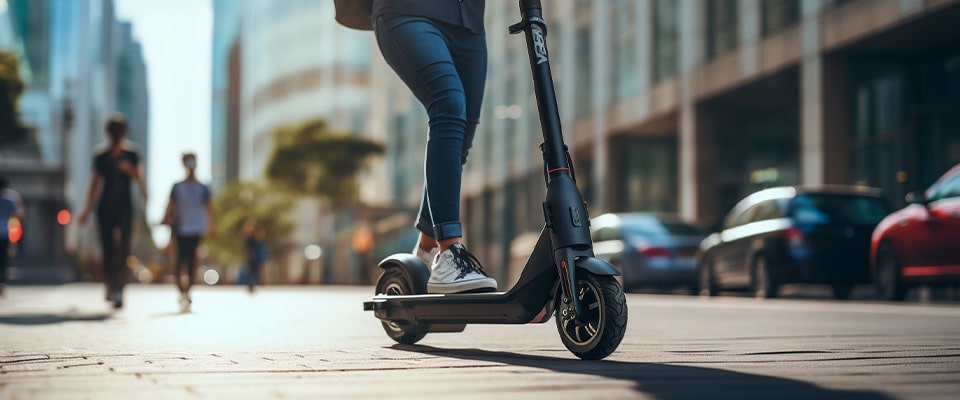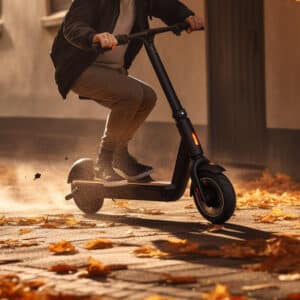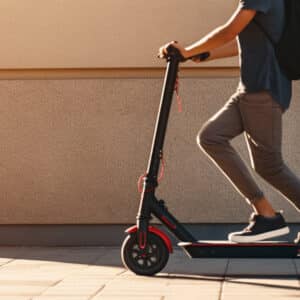Your Comprehensive Guide to Electric Scooter Batteries
Last updated Wednesday, September 18th, 2024

How to Choose the Right Battery For Your E-Bike
Flying cars used to be our idea of the future 50 years ago, but the only thing we got was flying fuel costs. E-scooters have come as a breath of fresh air making every ride more efficient, convenient, and enjoyable. A popular study revealed that scooters offer over 1,000% more efficiency per mile than the average combustion vehicle. What’s the secret behind their tremendous performance? Electric scooter batteries.
We’ve come a long way from toy electric scooters that were slow and had less powerful batteries. Thanks to the massive evolution in battery performance, electric scooters can easily zip through traffic without losing much power.
However, not all electric scooter batteries are created equal. Their performance depends on their capacity, size, and output. When you pay for an e-scooter, it’s actually the battery quality that offers the biggest value. It is the heart of your vehicle after all. It determines your scooter’s speed and mileage. It powers the motor, lights, controller, and display.
In this comprehensive guide, we’ll dive into the world of electric scooter batteries. There are a ton of factors to evaluate before buying an e-scooter like different battery types, and their key metrics. You’ll also understand how to prolong battery life and how to pick the best battery for your lifestyle needs.
Understanding Battery Power Metrics
Do the terms Voltage (V), Amp-Hours (Ah), and Watt-Hours (Wh) sound confusing to you? You don’t need to be an electrical engineer to ride an electric scooter. However, you do need a basic understanding of these terms. They define your battery power performance after all.
Here’s a simple way to understand and evaluate your e-scooter’s battery power metrics:
- Voltage (V) – Want to know the amount of electric potential in a battery? You need to know its voltage. It’s the measured strength of electricity flowing through a wire. Want to know why we call it an electric current? Because electricity is simply a flow of free electrons from a positive to a negative terminal. Voltage is the electric pressure that keeps these electrons flowing in one direction. It functions a lot like how the water pressure in your hose pumps water from the source out of the hose. Voltage ensures the smooth delivery of electric current through the circuit. Most electric scooter batteries range from 36V to 84V. The higher the voltage, the stronger the flow of electric current. Naturally, your motor is going to achieve faster acceleration. You should ideally pick a battery whose output is greater than the motor’s input voltage for peak performance.
- Amp-Hours (Ah) – Amp-Hours helps you understand the size of your vehicle’s fuel tank. An amp-hour (Ah) is a unit that reveals how much electric charge your battery can provide in an hour. For instance, a 3 Ah battery can deliver an 8 amp current for an hour. However, if you connect this battery to a device that only needs 4 amps, it can run for two hours. Most scooters offer a battery charge capacity ranging from 2 Ah to 50 Ah. The greater the amp-hour rating of your e-scooter’s battery, the more charge it can store. It helps you clearly understand the mileage of your vehicle.
- Watt-Hours (Wh) – Watt-hours are another key metric that reflects your electric scooter’s mileage. They are a product of Voltage and Amp-Hours. It measures the power used by the battery in an hour. For instance, a 36 V 10 Ah battery will provide 360 Wh of electrical energy. So your electric scooter will be able to cover 25-30 miles on a fully charged battery. The higher the watt-hours, the more electrical energy your battery can store. Average electric scooter batteries can range from 100 Wh to almost 3000 Wh.
Mathematically, here’s how they’re all tied together:
– 1V = 1 Wh / 1 Ah
– 1 Ah = 1WH / 1V
– 1 Wh = 1 Ah x 1V
However, there’s a simpler way for you to understand their combined value. Think of Voltage as the horsepower of your battery, Amp-Hours as the size of your fuel tank, and Watt-Hours as the total energy capacity.
Exploring Electric Scooter Battery Types
Here are the three most widely used types of electric scooter batteries that you should know about:
- Lithium-Ion – Lithium-ion batteries are one of the biggest driving forces behind the revolution in electric battery performance over the past two decades. They can power a wide range of devices like electric scooters, power tools, laptops, and even the smartphone you’re reading this article on. Discharging lithium-ion batteries produces a unique electrochemical reaction. The lithium atoms on the battery’s negative side get ionized. This triggers a flow of electrons through the battery circuits. Why Lithium? Because its highly reactive nature makes it perfect for giving up its electrons. This property makes it much easier for it to accumulate electric charge. Lithium-ion batteries are compact, lightweight, and require minimal maintenance. They last longer and usually provide better mileage than other battery types available in the market. So if you’re planning to regularly use your electric scooter for commutes, this is the only battery type you can rely on.
- Lead-acid – These batteries have been around since the 19th century. Lead-acid batteries are slowly being phased out because of their limitations. They are large, inefficient, and require a lot of maintenance. The biggest benefit you can get is their low price. Lead-acid batteries contain tightly packed lead sheets. These sheets are kept immersed in sulphuric acid, which produces a controlled chemical reaction. The lead starts losing electrons that start flowing through the battery’s circuits. You may find their low price attractive. However, their heavy size, high maintenance, and low mileage may actually force you to spend a lot more money in the long run. It’s best to use them only as a recreational electric scooter for your kid or for minimal-distance commutes.
- Nickel-Metal Hydride – These batteries emerged between the era of lead-acid batteries and lithium-ion batteries. Nickel-metal hydride batteries use nickel hydroxide and another metal to create an electric current. They are a little lighter than lead-acid batteries and can store more charge. However, they can easily break down after 200-250 cycles of charging. If you don’t use them actively, these batteries will start discharging quickly too.
Battery Performance and Prolonging Battery Life

A Lithium-ion battery is capable of 300 and 500 charge cycles before it starts deteriorating. How many miles can that help you cover? Between 3,000 to 10,000 miles. The average electric scooter battery will last for one to three years. A high-quality battery will be able to deliver peak performance up to 500 cycles before its speed and mileage start dropping.
It’s possible to understand your battery’s strengths and limitations before you take it for a spin. It’s possible that you and your neighbor buy the same electric scooter on the same date and get a radically different experience after a year. It’s not about the scooter; it’s about who rides it. And there’s a fine line between using and abusing your scooter’s battery.
Let’s see what you can do to optimize your battery performance and prolong its life:
- Battery life and charge cycles – What counts as one charge cycle? When you completely deplete the battery and then charge it fully again. The more charge cycles you put it through, the faster it loses its capacity. That’s why you shouldn’t wait to recharge your battery till it’s fully depleted. Plug it in before it falls below 10 percent. Try to charge your battery fully before going for a ride. Check the manufacturer’s guide to find out how long the battery can run on a full charge.
- Avoid extreme temperatures – Lithium-ion batteries are vulnerable to extreme hot, cold, or humid conditions. They can get damaged and even explode in worst-case scenarios. Choose a cool and dry place to store your scooter avoiding direct sunlight exposure.
- Reduce weight load – Avoid burdening your scooter with heavy baggage, especially for long rides. It’ll only drain your battery faster while slowing down your scooter.
- Maintain the right tire pressure – Check your scooter’s tire pressure from time to time. Under-inflated tires can increase rolling resistance and force your scooter to draw more battery power to move.
- Avoid rough terrain –: Steep hills and rugged terrain will take a toll on your scooter’s parts and its battery life. Stick to flatter, well-laid routes to save battery power.
- Smooth riding style – Avoid stressing your motor with sudden acceleration and braking motions. Ride at moderate speeds and maintain a smooth riding style to conserve your battery life.
- Battery Management Systems (BMS) – Most modern electric scooters utilize a Battery Management System to automatically protect their battery life. It monitors all voltage and temperature-related issues and optimizes your battery performance effortlessly. It balances your scooter’s charging and discharge cycles to prevent any damage.
Battery Maintenance and Replacement
A little care goes a long way to preserve your electric scooter’s battery. You won’t need to visit a mechanic again and again if you know how to do some simple maintenance work.
Here are some essential tips to help you take care of your battery:
- Know your battery capacity and range – Your scooter’s specifications define its limitations. Your battery’s voltage, energy capacity, and range determine its speed and mileage. You must plan your trips based on these factors so that you can ride and charge them at the right time.
- Choose the right charger – Stick to the charger given by the manufacturer. Alternative charging cables available in the market may not meet your battery specifications. They could overcharge or undercharge your scooter, which can cause permanent damage.
- Plug it into the charger at the right time – Your scooter’s battery gets heated up after long trips. Plugging it into the charger right after it can lead to overheating issues that’ll damage battery life. Allow your scooter to cool down for at least 30 minutes before you start charging it.
- Recognizing the time for a replacement – Once a battery crosses its limited charge cycles, you’ll start noticing many visible signs of its deterioration. The most noticeable ones will be your scooter’s reduced mileage and speed. That’s when you know it’s time for a battery replacement.
- Warranty coverage – Check your scooter’s warranty to see if it covers battery replacements. Always opt for genuine replacement batteries from reputable sellers. Ensure you get a battery with the exact same specifications as provided by the manufacturer.
Battery Cells: 18650 vs 21700
When you open up a lithium-ion battery pack, it may look quite familiar to you. It basically looks like someone strapped a bunch of AA batteries together to create a super battery. Lithium-ion battery packs use two popular cell types:
- 18650 Battery Cells – These battery cells are 18 mm in diameter and 65 mm in length. They have been the industry standard for a while and are widely used in a variety of devices. They offer good performance and are easily available. Secondly, they offer a healthy balance of capacity and weight.
- 21700 Battery Cells – These battery cells are 21 mm in diameter and 70 mm in length. 21700 cells came into the industry recently and don’t have a long, proven track record yet. However, it’s clear that they do offer more capacity than 18650 cells. They can help you get better power and mileage for your electric scooter.
Choosing the Best Battery for Your Electric Scooter
There’s no one-size-fits-all solution for your electric scooter’s battery. It’s more about what fits your lifestyle.
Here are some essential factors to consider for choosing the best battery for your electric scooter:
- How do you plan to use your scooter? – Do you need it for a 5-minute grocery shopping trip? Is it for long work commutes? Or is it just meant to be a recreational vehicle for your kids? This will help you figure out your scooter’s speed and mileage requirements. You don’t need heavy-duty battery packs for short trips around your block.
- What is your budget? – Your budget should reflect the performance and range you desire. Set a budget that aligns with the level of performance and range you desire. Remember, investing in a reliable battery pays off in the long run. Batteries with higher voltage and Ah ratings tend to cost higher.
- How heavy is the battery? – Your battery weight has a great impact on your scooter’s overall weight and balance. Lighter battery packs allow you to easily maneuver your vehicle in tight spots.
- How long does it take to charge? – Choose a battery with a shorter charging time, especially if you need to use it frequently.
- Does it have a battery management system (BMS)? – Electric scooters with BMS help automate a lot of essential battery maintenance work. It’ll protect your battery from being damaged by sudden voltage and temperature shifts. You’ll be able to extend your battery life and ensure it runs safely.
- Which brands should you rely on? – Check out a variety of reviews for the electric scooter options you’re considering. They’ll help you get deeper insights into their battery performance and longevity. Some of the most popular brands include LG, Samsung, and Dynavolt.
Pros and Cons of Different Battery Placements

Here are the three most commonly used battery placements in electric scooters:
- Stem Batteries – These batteries are attached to your scooter’s stem. This placement offers excellent weight distribution and stability. You’re less likely to damage them since they’re further away from the ground. They are constantly air-cooled because of their higher placement, which prevents overheating issues. However, the top-heavy design and thicker scooter stems do make it a little challenging to navigate your scooter.
- Deck Batteries – These battery packs are integrated into your scooter’s deck. It lowers the vehicle’s center of gravity and makes it more balanced. The narrower scooter stem is easy to wrap your hands around and navigate with. Although it does increase storage space and makes your vehicle sleeker, it does lower your deck’s height. Your batteries are more likely to face damage on rough or uneven surfaces since they’re closer to the ground. They are also more likely to be plagued by overheating issues due to a lack of proper ventilation.
- Removable Batteries – The best part about removable battery packs is that they make charging more convenient than ever. You can detach the battery pack and plug it in wherever you want inside your home. You don’t have to worry about finding charging stations or making room inside your home for the scooter. You can also buy additional batteries to customize your scooter’s range. However, scooters with removable battery placements tend to have thicker stems.
Your electric scooter’s battery life depends on two key factors: Most electric scooter batteries offer 300 to 500 charge cycles. You’ll be able to cover at least 3,000 to 10,000 miles with this capacity. Once your scooter crosses this mark, you’ll see a noticeable drop in speed and mileage. A good quality battery pack that is properly maintained should run smoothly for one to three years. A charge cycle is the process of fully depleting and recharging a battery. Every battery pack has a fixed limit of charge cycles (300-500). Your battery life will start depleting gradually once you cross this mark. Longer charging hours won’t help fix this issue either. The more charge cycles you use up, the lower your battery capacity becomes. You should consider getting a battery replacement once this happens. Yes. It might be possible with certain models, but it’s best to consult your scooter’s manufacturer or authorized service center. A fully charged electric scooter can cover 10 to 40 miles based on its battery specifications. Sometimes, your needs may evolve over time. You may need to make longer commutes. It doesn’t mean you have to buy a new electric scooter. You can simply attach another battery pack and double your mileage overnight. However, your battery’s total voltage output should not exceed the motor’s input voltage. 18650 battery cells are 18 mm in diameter and 65 mm in length. They have a long track record of strong performance in the industry. They are easily available in the market and provide good weight distribution and energy capacity for your scooter. On the other hand, 21700 battery cells are the new kids on the block. They are 21 mm in diameter and 70 mm in length. 21700 cells don’t have a strong proven track record yet. Their biggest advantage is the increased capacity they provide you compared to 18650 cells. Your scooter will have much faster acceleration and longer mileage if you use them. The most reliable way to pick out the right replacement battery for your scooter is to consult an authorized retailer or manufacturer. They’ll know the precise battery specifications you need. Here are a few important steps to take to maximize your electric scooter’s battery lifespan: FST batteries might be more affordable, but they might not offer the same level of quality and reliability as well-established brands like LG, Samsung, and Dynavolt. The higher your scooter’s voltage, amp-hour, and watt-hour specifications go, the more heavy-duty its battery will be. Most electric scooters are built for quick commutes at moderate speeds without heavy mileage needs. However, you can find great options if you have a need for speed and enjoy long-distance rides. Naturally, you’ll have to buy a model with a powerful battery pack. Two highly popular contenders in this segment are the Kaabo Wolf King GT Pro and Dualtron X electric scooters. The Wolf King GT Pro uses a 72V battery and has dual 2000W motors. It can reach top speeds of 62 mph and has a range of 111 miles. The Dualtron X has a 60V 52 Ah battery that allows you to hit top speeds of 37.3mph with a range of 95 miles. Most electric scooters need to have their battery pack replaced within one to three years. Once it crosses 300-500 charge cycles, it’s the beginning of the end. You may be following a healthy maintenance routine, but you’ll notice an increasing performance drop. Your battery will start draining out faster, which means your scooter’s mileage will never be the same. This is the time to replace your battery pack. Battery replacement costs vary depending on the scooter model and battery type but can range from $100 to $400.Frequently Asked Questions
How long do electric scooter batteries typically last?
What are charge cycles, and how do they affect battery performance?
Can I upgrade the battery in my electric scooter to improve its range?
What is the difference between 18650 and 21700 battery cells?
Where can I find replacement batteries for my specific scooter brand?
How can I increase the lifespan of my electric scooter battery?
Are FST batteries as reliable as name-brand batteries like LG, Samsung, and Dynavolt?
What is the largest battery available for electric scooters, and which scooter model uses it?
How do I know when it's time to replace my electric scooter battery?
What is the average cost of replacement batteries for electric scooters?









